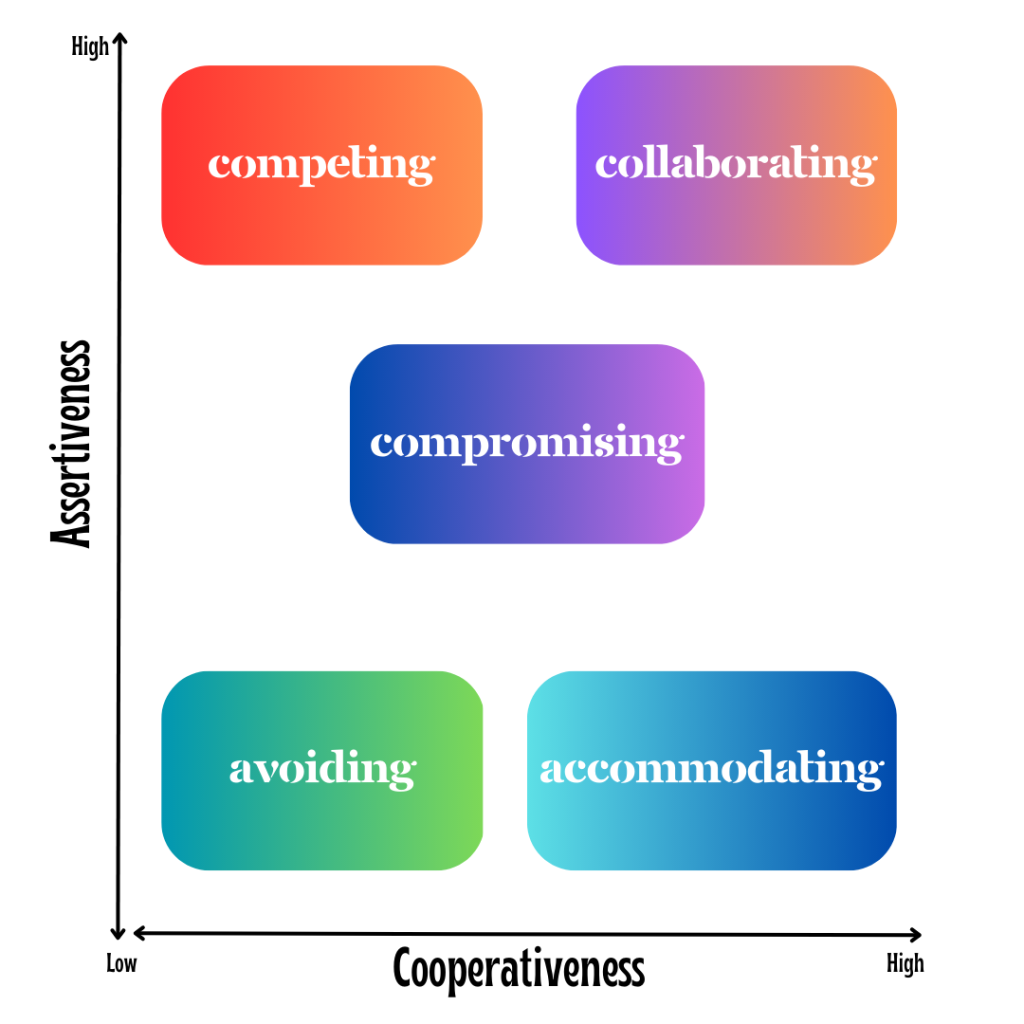9 Can’t Fight This Feeling
Meet Jayesha and Marshawn
Jayesha and Marshawn have been dating since junior high school. They are now in college and have been pursuing different interests. Marshawn has felt that it was time to end things with Jayesha and tries to talk to her about breaking up the relationship. Jayesha believes that the relationship is meant to last and that they are just going through a rough patch. Jayesha believes that they will get married one day. Marshawn has tried to confront Jayesha several times by telling her that it is over and their feelings have changed. Jayesha refuses to listen and doesn’t want to deal with any conflict. Marshawn is so frustrated that they leave and slash Jayesha’s tires on her brand-new car. Marshawn blocks Jayesha from all their social media platforms and moves to another college.
This story is an example of interpersonal conflict. This story illustrates how conflict can develop over time. It also illustrates how some disagreements can sometimes never be truly resolved. Marshawn didn’t handle the situation effectively. People can decide how they want to deal with problems or relational issues. Most people have a fight-or-flight response to conflict. In this chapter, we will discuss conflict, conflict management, conflict styles, and conflict resolution.
Understanding Conflict
Often times people don’t know how to engage in effective conflict, which is a great reason to study conflict. Obviously, Marshawn could have handled the conflict differently. Marshawn did not have to slash tires or move to another college. Some people engage in conflict through verbal abuse or physical violence, which can have detrimental consequences. In this chapter, we will learn more beneficial ways to deal with conflict.
Interpersonal conflict is a natural and unavoidable part of human relationships. Conflict arises when two or more individuals disagree on a matter, leading to a negative emotional state. Interpersonal conflict can occur in various settings, including families, workplaces, and schools. It can be caused by differences in personality, values, and misunderstandings. The effects of interpersonal conflict can be significant and far-reaching. It can lead to stress, anxiety, and even depression. Moreover, conflicts can result in physical harm, such as fights or assaults. Conflict can also damage relationships, leading to feelings of resentment and hostility. Therefore, it is essential to manage interpersonal conflicts effectively to prevent them from escalating and causing harm.
This chapter explores the causes and effects of interpersonal conflict, as well as strategies for managing conflict effectively. We will also learn more about the different conflict styles because everyone has a different approach to conflict. By understanding the causes of interpersonal conflict and learning effective conflict management strategies, individuals can resolve conflicts and build stronger relationships.

When was the last time you experienced conflict? What was it about? Looking back, do you feel like you and your relational partner handled it well?
9.1 Causes of Interpersonal Conflict
Interpersonal conflicts can arise due to various factors (Winstok, 2006). Understanding these factors can help individuals prevent conflicts from occurring or manage them effectively when they do occur. Some common causes of interpersonal conflict are discussed below:
Personality Differences
Individuals have different personality traits, which can lead to differences in opinions and preferences. For example, an introverted person may prefer to spend time alone, while an extroverted person may enjoy socializing with others. This difference in preference can lead to conflicts, especially if both individuals are required to work together. Different personality styles influence perceptions as well. For instance, if one person is very shy and their partner is not, their partner might perceive them as being unfriendly and distant, when in fact, they are too shy to talk. These differences in personality affect the way in which we perceive but also communicate with others.
Differences in Values
Values are beliefs that people hold about what is right and wrong. When individuals with different values interact, conflicts can arise. For example, a person who values honesty may be upset with someone who lies. People are more likely to get upset with others who do not share similar values.
Misunderstandings
Misunderstandings occur when individuals interpret the same situation differently. For example, two coworkers may have different interpretations of a conversation they had with their boss, leading to a conflict. Misunderstandings can also arise due to differences in communication styles, language barriers, or cultural differences. Another example might be a professor that assigns a quiz, but two students got the date of the quiz confused. One person thought it was Monday and the other student thought it was next Monday, so they might have gotten upset because they didn’t prepare accordingly.
Limited Resources
Conflicts can arise when individuals compete for limited resources, such as money, time, or attention. For example, siblings may argue over who gets to use the family car, or coworkers may compete for a promotion. Often times on reality TV dating shows, contestants get dramatic and jealous when there is limited time with a specific bachelor or bachelorette. Hence, if there is only a limited amount, people get defensive if they don’t perceive getting the same amount as everyone else or if they can’t even access the resource.
Power Imbalances
Power imbalances occur when one individual has more power or influence than the other. For example, a boss may have more power than an employee or a teacher may have more power than a student. Power imbalances can lead to conflicts when the less powerful individual feels disrespected or mistreated. Conflict can definitely arise if certain people feel that they have been mistreated by a person who abused their power.
9.2 Effects of Interpersonal Conflict
Interpersonal conflict can have a significant impact on individuals and their relationships (Wellenfelz & Hample, 2010). The effects of interpersonal conflict can be physical, emotional, and social. Some common effects of interpersonal conflict are discussed below.
Physical Effects
Interpersonal conflict can lead to physical harm, such as fights or assault. It can also result in physical symptoms, such as headaches, stomach aches, or fatigue. Moreover, prolonged exposure to conflict can weaken the immune system, leading to a higher risk of illness.
Emotional Effects
Interpersonal conflict can lead to negative emotions, such as anger, frustration, and sadness. It can also lead to stress, anxiety, and even depression. Moreover, conflict can damage self-esteem and self-worth, leading to feelings of insecurity and inadequacy.
Social Effects
Interpersonal conflict can damage relationships, leading to feelings of resentment and hostility. It can also lead to social isolation, as individuals may avoid social situations to prevent conflict. Moreover, prolonged exposure to conflict can lead to a breakdown in communication and cooperation, leading to reduced productivity and effectiveness.
Discussion Questions
- How would you describe conflict situations that you have encountered?
- How do you think they have shaped your relationships?
9.3 Conflict Management
Conflict management is a crucial aspect of interpersonal relationships, both in personal and professional settings. Conflict can arise due to various reasons, including personality differences, misunderstandings, and differences in values (Montes et al., 2012). The effects of interpersonal conflict can be significant, leading to physical, emotional, and social consequences. Therefore, it is essential to manage conflict effectively to prevent it from escalating and causing harm.
One effective conflict management strategy is to identify the source of the conflict. Often, conflicts arise due to differences in opinions, preferences, or values. By understanding the root cause of the conflict, individuals can work towards resolving it. For example, if a conflict arises due to a difference in opinion, individuals can seek to understand each other’s perspectives and find a middle ground. Effective communication is crucial in conflict management. Clear communication can help prevent misunderstandings and misinterpretations. When communicating during a conflict, it is essential to use active listening skills, which involve paying attention to the other person’s words, tone, and body language. It is also important to express oneself clearly and assertively, without being aggressive or defensive.
Another important aspect of conflict management is to remain calm and composed. Conflict can be emotionally charged, and it is easy to get carried away by one’s emotions. However, by remaining calm, individuals can approach the situation objectively and work towards finding a solution. Taking deep breaths, counting to ten, or taking a break can help individuals calm down and approach the situation with a clear mind. Compromise is also an effective conflict management strategy. Often, conflicts arise due to differences in preferences or goals. By compromising, individuals can find a middle ground that satisfies both parties. However, compromise does not mean sacrificing one’s needs or values. Instead, it involves finding a solution that is acceptable to both parties.
In some cases, seeking the help of a third party can be beneficial in conflict management. A neutral third party can help facilitate communication and find a resolution that is acceptable to both parties. This can be especially helpful in situations where the conflict has become highly charged or complex. Finally, it is essential to learn from the conflict and take steps to prevent it from occurring again. Reflecting on the conflict can help individuals understand the root cause and identify strategies to prevent it from happening again in the future. It can also help individuals develop a better understanding of themselves and their communication styles.
In conclusion, conflict management is an essential aspect of interpersonal relationships. Effective conflict management involves identifying the source of the conflict, communicating effectively, remaining calm and composed, compromising, seeking the help of a third party, and learning from the conflict. By understanding conflict management strategies, individuals can resolve conflicts and build stronger relationships.
9.4 Conflict Styles
Would you like to learn your conflict style?
Take the Conflict Styles quiz here. After taking the quiz, reflect on your results. Do you think they are accurate? Can you recall a recent conflict and spot indicators of your conflict style in the way you handled that conflict?
Conflict is a natural part of human interaction and can arise in various settings, including personal and professional relationships. How individuals approach and handle conflict can have a significant impact on the outcome and the relationship between the parties involved. In this section, we will discuss the five conflict styles and how individuals can use them to manage conflict effectively.
The first conflict style is avoidance. Avoidance involves ignoring or sidestepping the conflict altogether. Individuals who use this style tend to withdraw from the situation and avoid confrontation. While avoidance may seem like an easy way out, it can lead to further misunderstandings and resentment.
The second conflict style is accommodation. Accommodation involves putting the needs of others before one’s own needs. Individuals who use this style tend to give in to the other party’s demands to maintain harmony. While accommodation can be useful in situations where the issue is minor or when preserving the relationship is essential, it can also lead to individuals feeling ignored or taken for granted.
The third conflict style is competition. Competition involves a win-lose mentality, where the individual focuses on their own needs and goals, often at the expense of others. Individuals who use this style tend to be aggressive and may use power or force to achieve their objectives. While competition can be effective in some situations, such as negotiations, it can also damage relationships and lead to further conflict.
The fourth conflict style is compromise. Compromise involves finding a middle ground that satisfies both parties’ needs and interests. Individuals who use this style tend to be flexible and willing to give and take. While compromise can be effective in resolving conflicts, it can also result in a suboptimal solution that does not fully address the underlying issue.
The fifth conflict style is collaboration. Collaboration involves working together to find a solution that satisfies both parties’ needs and interests. Individuals who use this style tend to be open-minded, creative and focused on finding a win-win solution. Collaboration can lead to better relationships, improved outcomes, and increased trust between the parties involved.

Each conflict style has its strengths and weaknesses, and the appropriate style will depend on the situation and the individuals involved. For example, avoidance may be appropriate in situations where emotions are running high and may lead to further escalation. Accommodation may be appropriate when the issue is minor, and preserving the relationship is essential. Competition may be appropriate in negotiations, where the parties are trying to achieve their objectives. Compromise may be appropriate when there is a limited time frame and finding a solution quickly is essential. Collaboration may be appropriate when building long-term relationships, and both parties are committed to finding a mutually beneficial solution.
Conflict styles are an essential aspect of managing conflict effectively. By understanding the five conflict styles and their strengths and weaknesses, individuals can approach conflict with a clear mind and find a solution that satisfies both parties’ needs and interests. Conflict management is a crucial skill that can help individuals build stronger relationships and achieve better outcomes in personal and professional settings (Bell & Song, 2005).
9.5 Constructive and Deconstructive Conflict Styles
As we have seen in the scenario between Jayesha and Marshawn, interpersonal relationships are often tested by conflicts, but the strategies people use to manage them can have a significant impact on the relationship. Constructive and deconstructive conflict strategies are two different approaches that people can use when managing conflict.
Constructive conflict strategies involve managing conflict in a way that promotes positive outcomes for all parties involved. This can include seeking to understand the other person’s perspective, actively listening, and finding solutions that are mutually beneficial. It also involves being assertive and expressing one’s needs and opinions in a way that is respectful and non-threatening.
On the other hand, deconstructive conflict strategies involve managing conflict in a way that harms the relationship and can have negative consequences for all parties involved. This can include attacking the other person’s character, using aggressive language, and refusing to listen to the other person’s point of view. Deconstructive strategies can escalate conflicts and make resolution difficult or impossible.
Effective conflict management requires individuals to use constructive strategies to resolve differences while minimizing harm to the relationship (Merolla, 2014). This means being willing to compromise, avoiding personal attacks, and seeking common ground. It also involves being open to feedback and being willing to admit when one is wrong.
Ultimately, the goal of constructive conflict strategies is to promote healthy relationships and build trust between individuals. By using effective communication skills and showing empathy and understanding, people can resolve conflicts in a way that strengthens their relationship and allows them to move forward positively (Feiring et al., 2018).

Conflict resolution looks different for each unique situation. Can you think of two different kinds of resolution you have experienced?
9.6 Practicing Healthful Skills
Conflict is an inevitable part of human relationships, and it is essential to have effective conflict-resolution skills to maintain healthy relationships. Conflict resolution involves managing differences and disagreements in a way that promotes positive outcomes for all parties involved (Gdadamosi et al., 2014).
The first step in conflict resolution is to identify the source of the conflict. This requires active listening and seeking to understand the other person’s perspective. Active listening involves giving one’s full attention to the other person and seeking to understand their perspective. This means avoiding interrupting or dismissing their views and asking questions to clarify their position.
Once the source of the conflict is identified, it is important to communicate in a way that is assertive yet respectful. This means expressing one’s needs and opinions clearly and listening to the other person’s point of view. It also means avoiding aggressive language or personal attacks and focusing on the issue at hand. It involves being willing to listen to feedback and adjust one’s position as needed.
Once both parties have expressed their viewpoints, the next step is to find a mutually beneficial solution. This may involve compromise or finding a creative solution that meets both parties’ needs. Compromise is an essential aspect of conflict resolution. This means finding a solution that meets both parties’ needs and involves some level of give and take. It is important to remain open to new ideas and to be willing to make concessions to find a mutually beneficial solution.
Another important aspect of conflict resolution is managing emotions. Conflicts can be emotional, and it is important to remain calm and respectful throughout the process. This means avoiding personal attacks or aggressive language and focusing on the issue at hand.
Effective conflict resolution skills are essential for building and maintaining healthy relationships. By actively listening, communicating assertively yet respectfully, and finding mutually beneficial solutions, individuals can resolve conflicts in a way that promotes positive outcomes and strengthens their relationship
Closing Thoughts
Try to recall a time that someone was there for you when you needed them.
What can you learn from that experience? How have you been there for someone else?
The Chapter 9 Mixtape
-
-
-
-
Pat Benatar – “Hit Me with Your Best Shot”
-
Beastie Boys – “Fight for Your Right”
-
Carl Douglas – “Kung-Fu Fighting”
-
Survivor – “Eye of the Tiger”
-
Public Enemy – “Fight the Power”
-
-
-
Chapter References
Bell, C., & Song, F. (2005). Emotions in the conflict process: An application of the cognitive appraisal model of emotions to conflict management. The International Journal of Conflict Management, 16(1), 30-54. https://doi.org/10.1108/eb022922
Feiring, C., Simon, V. A., & Markus, J. (2018). Narratives about specific romantic conflicts: Gender and associations with conflict beliefs and strategies. Journal of Counseling and Development, 96(3), 254-266. https://doi.org/10.1002/jcad.12200
Gbadamosi, O., Ghanbari Baghestan, A., & Al-Mabrouk, K. (2014). Gender, age, and nationality: Assessing their impact on conflict resolution styles. The Journal of Management Development, 33(3), 245-257. https://doi.org/10.1108/JMD-02-2011-0024
Merolla, A. J. (2014). The role of hope in conflict management and relational maintenance. Personal Relationships, 21(3), 365-386. https://doi.org/10.1111/pere.12037
Montes, C., Rodríguez, D., & Serrano, G. (2012). Affective choice of conflict management styles. The International Journal of Conflict Management, 23(1), 6-18. https://doi.org/10.1108/10444061211199304
Wallenfelsz, K. P., & Hample, D. (2010). The role of taking conflict personally in imagined interactions about conflict. The Southern Communication Journal, 75(5), 471-487. https://doi.org/10.1080/10417940903006057
Winstok, Z. (2006). The why and what of intimate conflict: Effect of the partners’ divergent perceptions on verbal aggression. Journal of Family Violence, 21(7), 461-468. https://doi.org/10.1007/s10896-006-9043-1
hen two or more individuals disagree on a matter, leading to a negative emotional state
preventing conflict from occurring, and de-escalating it when it does occur so no harm is caused
ignoring or sidestepping conflict altogether
putting the needs of others before one's own needs in a conflict
win-lose conflict mentality, where the individual focuses on their own needs and goals, often at the expense of others
finding a middle ground that satisfies both parties' needs and interests
working together to find a solution that satisfies both parties' needs and interests
strategies that manage conflict in a way that promotes positive outcomes for all parties involved
strategies that manage conflict in a way that harms the relationship and can have negative consequences for all parties involved


